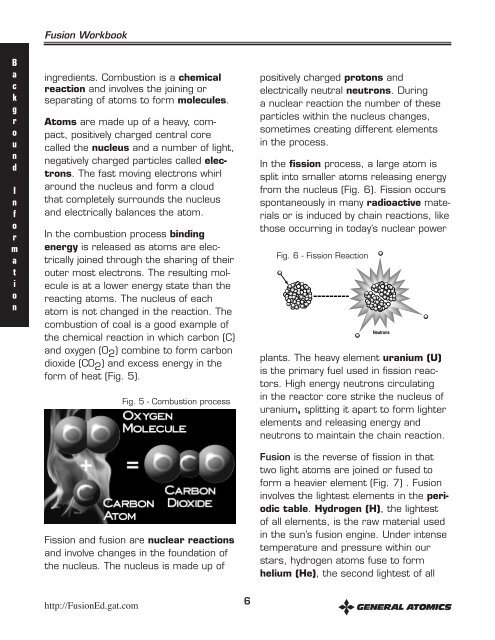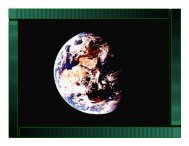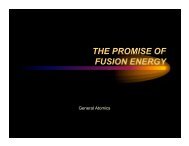Workbook: Fusion Natures Fundamental Energy Source - General ...
Workbook: Fusion Natures Fundamental Energy Source - General ...
Workbook: Fusion Natures Fundamental Energy Source - General ...
You also want an ePaper? Increase the reach of your titles
YUMPU automatically turns print PDFs into web optimized ePapers that Google loves.
<strong>Fusion</strong> <strong>Workbook</strong><br />
B<br />
a<br />
c<br />
k<br />
g<br />
r<br />
o<br />
u<br />
n<br />
d<br />
I<br />
n<br />
f<br />
o<br />
r<br />
m<br />
a<br />
t<br />
i<br />
o<br />
n<br />
ingredients. Combustion is a chemical<br />
reaction and involves the joining or<br />
separating of atoms to form molecules.<br />
Atoms are made up of a heavy, compact,<br />
positively charged central core<br />
called the nucleus and a number of light,<br />
negatively charged particles called electrons.<br />
The fast moving electrons whirl<br />
around the nucleus and form a cloud<br />
that completely surrounds the nucleus<br />
and electrically balances the atom.<br />
In the combustion process binding<br />
energy is released as atoms are electrically<br />
joined through the sharing of their<br />
outer most electrons. The resulting molecule<br />
is at a lower energy state than the<br />
reacting atoms. The nucleus of each<br />
atom is not changed in the reaction. The<br />
combustion of coal is a good example of<br />
the chemical reaction in which carbon (C)<br />
and oxygen (O 2 ) combine to form carbon<br />
dioxide (CO 2 ) and excess energy in the<br />
form of heat (Fig. 5).<br />
Fig. 5 - Combustion process<br />
Fission and fusion are nuclear reactions<br />
and involve changes in the foundation of<br />
the nucleus. The nucleus is made up of<br />
positively charged protons and<br />
electrically neutral neutrons. During<br />
a nuclear reaction the number of these<br />
particles within the nucleus changes,<br />
sometimes creating different elements<br />
in the process.<br />
In the fission process, a large atom is<br />
split into smaller atoms releasing energy<br />
from the nucleus (Fig. 6). Fission occurs<br />
spontaneously in many radioactive materials<br />
or is induced by chain reactions, like<br />
those occurring in today’s nuclear power<br />
Fig. 6 - Fission Reaction<br />
Neutrons<br />
plants. The heavy element uranium (U)<br />
is the primary fuel used in fission reactors.<br />
High energy neutrons circulating<br />
in the reactor core strike the nucleus of<br />
uranium, splitting it apart to form lighter<br />
elements and releasing energy and<br />
neutrons to maintain the chain reaction.<br />
<strong>Fusion</strong> is the reverse of fission in that<br />
two light atoms are joined or fused to<br />
form a heavier element (Fig. 7) . <strong>Fusion</strong><br />
involves the lightest elements in the periodic<br />
table. Hydrogen (H), the lightest<br />
of all elements, is the raw material used<br />
in the sun’s fusion engine. Under intense<br />
temperature and pressure within our<br />
stars, hydrogen atoms fuse to form<br />
helium (He), the second lightest of all<br />
http://<strong>Fusion</strong>Ed.gat.com<br />
6<br />
QTYUIOP




